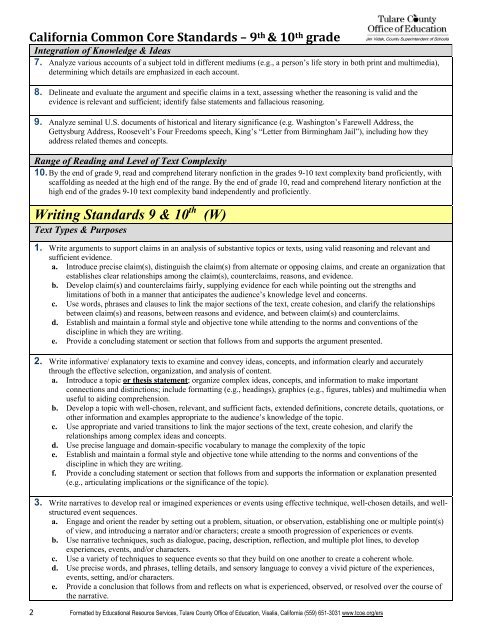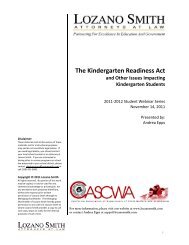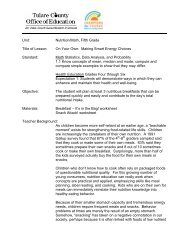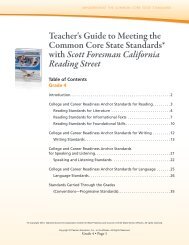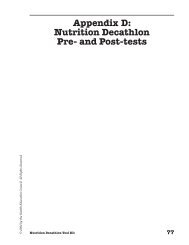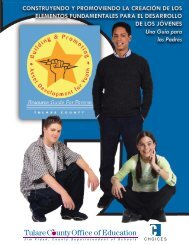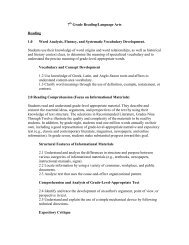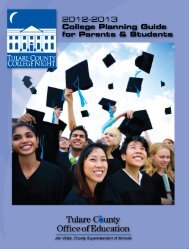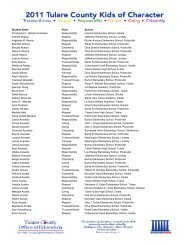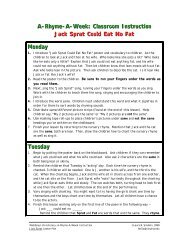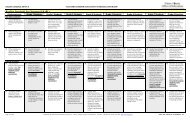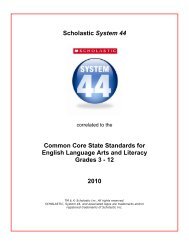Grades 9 & 10 - Tulare County Office of Education
Grades 9 & 10 - Tulare County Office of Education
Grades 9 & 10 - Tulare County Office of Education
Create successful ePaper yourself
Turn your PDF publications into a flip-book with our unique Google optimized e-Paper software.
California Common Core Standards – 9 th & <strong>10</strong> th gradeIntegration <strong>of</strong> Knowledge & Ideas7. Analyze various accounts <strong>of</strong> a subject told in different mediums (e.g., a person’s life story in both print and multimedia),determining which details are emphasized in each account.8. Delineate and evaluate the argument and specific claims in a text, assessing whether the reasoning is valid and theevidence is relevant and sufficient; identify false statements and fallacious reasoning.9. Analyze seminal U.S. documents <strong>of</strong> historical and literary significance (e.g. Washington’s Farewell Address, theGettysburg Address, Roosevelt’s Four Freedoms speech, King’s “Letter from Birmingham Jail”), including how theyaddress related themes and concepts.Range <strong>of</strong> Reading and Level <strong>of</strong> Text Complexity<strong>10</strong>. By the end <strong>of</strong> grade 9, read and comprehend literary nonfiction in the grades 9-<strong>10</strong> text complexity band pr<strong>of</strong>iciently, withscaffolding as needed at the high end <strong>of</strong> the range. By the end <strong>of</strong> grade <strong>10</strong>, read and comprehend literary nonfiction at thehigh end <strong>of</strong> the grades 9-<strong>10</strong> text complexity band independently and pr<strong>of</strong>iciently.Writing Standards 9 & <strong>10</strong> thText Types & Purposes(W)1. Write arguments to support claims in an analysis <strong>of</strong> substantive topics or texts, using valid reasoning and relevant andsufficient evidence.a. Introduce precise claim(s), distinguish the claim(s) from alternate or opposing claims, and create an organization thatestablishes clear relationships among the claim(s), counterclaims, reasons, and evidence.b. Develop claim(s) and counterclaims fairly, supplying evidence for each while pointing out the strengths andlimitations <strong>of</strong> both in a manner that anticipates the audience’s knowledge level and concerns.c. Use words, phrases and clauses to link the major sections <strong>of</strong> the text, create cohesion, and clarify the relationshipsbetween claim(s) and reasons, between reasons and evidence, and between claim(s) and counterclaims.d. Establish and maintain a formal style and objective tone while attending to the norms and conventions <strong>of</strong> thediscipline in which they are writing.e. Provide a concluding statement or section that follows from and supports the argument presented.2. Write informative/ explanatory texts to examine and convey ideas, concepts, and information clearly and accuratelythrough the effective selection, organization, and analysis <strong>of</strong> content.a. Introduce a topic or thesis statement; organize complex ideas, concepts, and information to make importantconnections and distinctions; include formatting (e.g., headings), graphics (e.g., figures, tables) and multimedia whenuseful to aiding comprehension.b. Develop a topic with well-chosen, relevant, and sufficient facts, extended definitions, concrete details, quotations, orother information and examples appropriate to the audience’s knowledge <strong>of</strong> the topic.c. Use appropriate and varied transitions to link the major sections <strong>of</strong> the text, create cohesion, and clarify therelationships among complex ideas and concepts.d. Use precise language and domain-specific vocabulary to manage the complexity <strong>of</strong> the topice. Establish and maintain a formal style and objective tone while attending to the norms and conventions <strong>of</strong> thediscipline in which they are writing.f. Provide a concluding statement or section that follows from and supports the information or explanation presented(e.g., articulating implications or the significance <strong>of</strong> the topic).3. Write narratives to develop real or imagined experiences or events using effective technique, well-chosen details, and wellstructuredevent sequences.a. Engage and orient the reader by setting out a problem, situation, or observation, establishing one or multiple point(s)<strong>of</strong> view, and introducing a narrator and/or characters; create a smooth progression <strong>of</strong> experiences or events.b. Use narrative techniques, such as dialogue, pacing, description, reflection, and multiple plot lines, to developexperiences, events, and/or characters.c. Use a variety <strong>of</strong> techniques to sequence events so that they build on one another to create a coherent whole.d. Use precise words, and phrases, telling details, and sensory language to convey a vivid picture <strong>of</strong> the experiences,events, setting, and/or characters.e. Provide a conclusion that follows from and reflects on what is experienced, observed, or resolved over the course <strong>of</strong>the narrative.2 Formatted by <strong>Education</strong>al Resource Services, <strong>Tulare</strong> <strong>County</strong> <strong>Office</strong> <strong>of</strong> <strong>Education</strong>, Visalia, California (559) 651-3031 www.tcoe.org/ers


